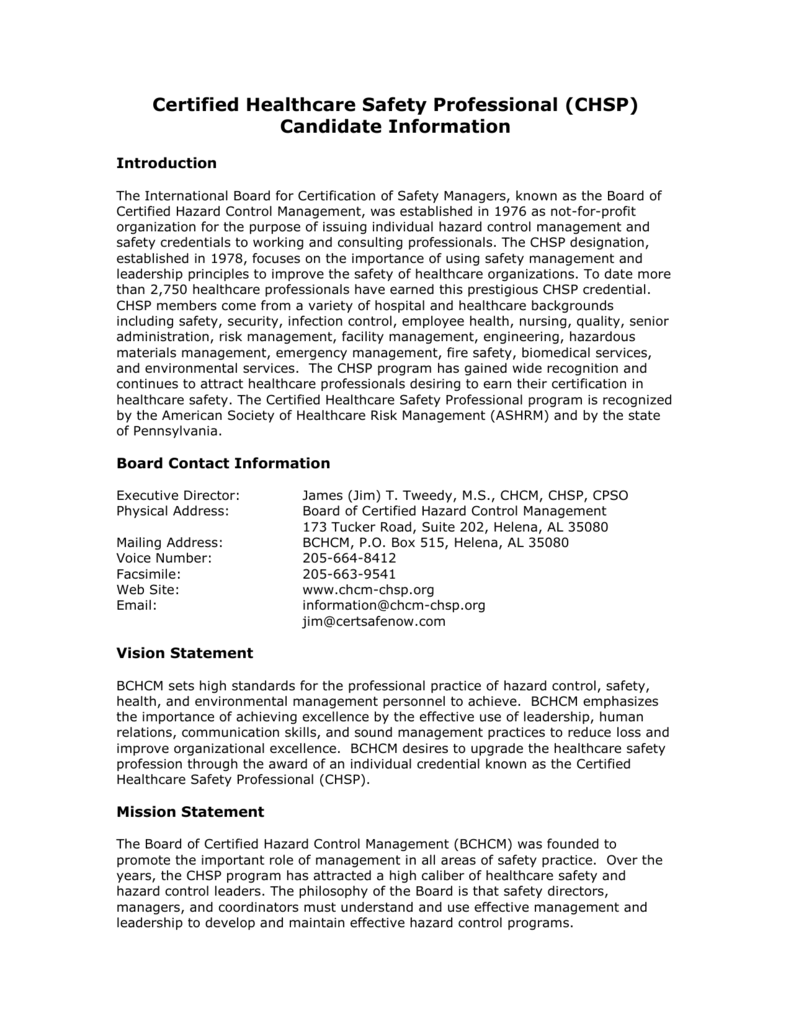Certified Healthcare Safety Professional Chsp Study Guide
The International Board for Certification of Safety Managers, also known as BCHCM, is proud to announce the new healthcare Fire Safety Management (FSM) designation. The FSM is a specialty endorsement designation to the existing Certified Healthcare Safety Professional (CHSP) credential. Applicants for the new FSM designation must hold the CHSP and be in good standing with the Board.
Any CHSP member can apply to sit for the FSM exam by completing an on-line application and paying the current examination fee of $150. There is currently no application fee. The Board does not need any supporting documentation such as reference forms or transcripts.
Certified Healthcare Emergency Professional
The FSM exam is comprehensive in scope and contains from 80-100 multiple choice questions. The exam is challenging but does not contain questions requiring math or engineering calculations. The exam content has been developed with the assistance of practicing professionals and subject matter experts. The Board statistically analyzes each exam to ensure the validity of all questions. The Board also uses analytical techniques to ensure the reliability of each exam version to access the competency of each candidate.
The growth in titles creates many questions for potential buyers and users of these programs. What makes one safety certification more worthwhile than another? Safety, and health fields are the National Commission for Certifying Agencies. A study involving about 1,500 safety professionals to re-validate professional.
Each exam may contain 5 to 10 'trial questions' that are being validated for use on future exam forms.
Description The International Board for Certification of Safety Managers, also known as BCHCM, was established in 1976 as a not-for-profit independent credentialing organization. The Board establishes certification and re-certification requirements for the Certified Healthcare Safety Professional (CHSP). The CHSP credential was established to focus on the importance of using management principles to improve the safety performance of healthcare organizations. Since 1978, the Board has issued more than 3,200 CHSP credentials.
Content Exam Content The exam is comprehensive in scope and contains from 100-125 multiple choice questions. The exam is challenging but does not contain questions requiring math or engineering calculations. The exam content has been developed with the assistance of practicing professionals and subject matter experts. The Board statistically analyzes each exam to ensure the validity of all questions. The Board also uses analytical techniques to ensure the reliability of each exam version to access the competency of each candidate. Each exam may contain 5 to 15 trial questions that are being validated for use on future exam forms.
The exam will contain questions from the following competency areas: 1. Safety Management (25% of Questions) 2. Government Agencies and Standards (22% of Questions) 3. Healthcare Hazard Identification, Evaluation, and Control (20% of Questions) 4.
Voluntary and Standards Organizations (13% of Questions) 5. Accrediting Organizations (8% of Questions) 6. Fire Safety (6% of Questions) 7. Infection Control and Prevention (6% of Questions) Curriculum Sample Example Questions 1. Which of the following would be the key benefit realized by a long term care facility that recently implemented a formal resident safe lifting program? Improved resident quality of care.

b. Reduced workers compensation costs c. Greater resident satisfaction d.
Increased morale for employees 2. Which NFPA publication exclusively addresses healthcare facility topics? Which control measure should be considered first when attempting to protect workers being exposed to chemical airborne contaminants? Isolating the hazard far from most workers b. Providing proper local and general ventilation.
c. Requiring use of supplied air respirators immediately d. Conducting periodic monitoring in all exposure areas 4. Which dietary hazard control would be least effective in preventing potential food-borne illnesses? Requiring food preparation workers to wash hands frequently b. Maintaining hot foods on the serving line at 140F or higher c. Providing a supply of cloth towels to wipe food prep surfaces frequently.
d. Maintaining coolers and refrigerators at 40F or lower 5. Which human health condition can be linked by analytical evidence to hazardous exposures found in built structures?
Occupational disease syndrome b. Multiple chemical sensitivity syndromes c. Sick building syndrome d. Building-related illness.
Specific Instructions CHSP Background The CHSP credential was established to focus on the importance of using management principles to improve the safety performance of healthcare organizations. Since 1978, the Board has issued more than 3,200 CHSP credentials. The broad scope of the CHSP Exam attracts applicants from various healthcare backgrounds including, but not limited to, safety, security, infection prevention, employee health, nursing, quality improvement, administration, risk management, facility management, plant operations, hazardous materials management, emergency management, life safety, biomedical services, environmental services, laboratory operations, nursing homes, surgery centers, insurance loss control, and safety consulting. The CHSP credential continues to attract applicants desiring to improve their professional practice in healthcare safety and related functions. Earning the CHSP credential provides recognition and documents achievement.